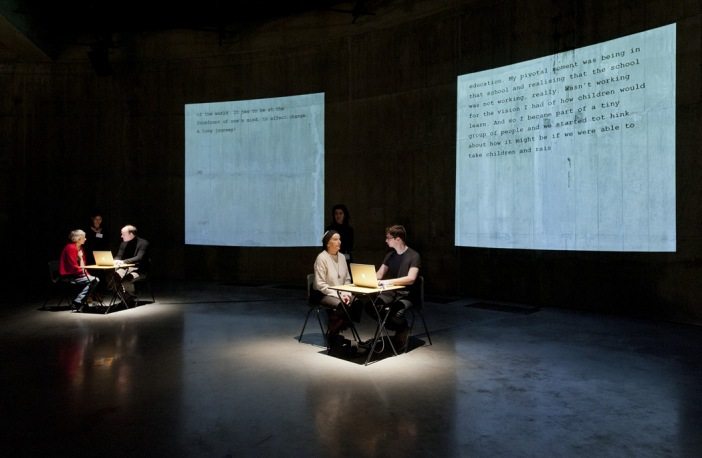
Performed as part of BMW Tate Live, Tate Modern, 3 February 2013. Photo © Tate
In early 2013, a few months after Tate Modern opened its first permanent performance galleries in the Tanks, hundreds of women over the age of sixty gathered together to share their personal stories of feminist activism and more covert forms of insurgence. They grouped around tables to reminisce or approached one of several stenographers, who typed away feverishly on laptops in order to produce live transcriptions that were projected onto the concrete walls behind them.
The project was envisaged by Suzanne Lacy, an American artist who has a long history of increasing female visibility through community outreach and collaboration. For example, her 1987 work The Crystal Quilt, which informed this new performance, brought together 430 women in a Minneapolis shopping centre in order to air their views on getting older. The participants sat around tables covered in bright yellow or red cloth, creating a patchwork that mimicked traditional quilting when seen from above. The subsequent video and documentation now form part of Tate’s collection and can be seen on the third floor of the Switch House.
Although the general set-up of Silver Action mimicked this older piece (with archive images even on show during the performance), the premise differed. Lacy was adamant that this was not a work about aging per se, but rather righting a record of history that might otherwise be forgotten: “I should say very clearly this is actually not a project about aging and not a sentimental project about older women… This is a project about discrimination and inequality.”
Sentimentality often creeps into any topic surrounding women “of a certain age”, and the fear of a cataclysmic invisibility is readily felt by many, including the erasure of their achievements. Silver Action combated this, not only because its participants included several prolific feminist campaigners such as abortion activist Ann Rossiter, but also the fact that its small, closed audience included younger women who live-tweeted and blogged about the six-hour event. In this way, they learned about the very real bravery, ferocity and ingenuity of their older peers, while simultaneously broadcasting their voices to a broader online audience.
What is so wonderful about Lacy’s work is the fact that it completely upends the romantic notion of an artist’s singular genius. She foregrounds each of her live spectacles with hours of workshops and interviews, resulting in newly forged communities and a glorious web of strength, support and knowledge. As an artist/activist she directly and tangibly changes the world she sees, as opposed to simply reflecting it.





